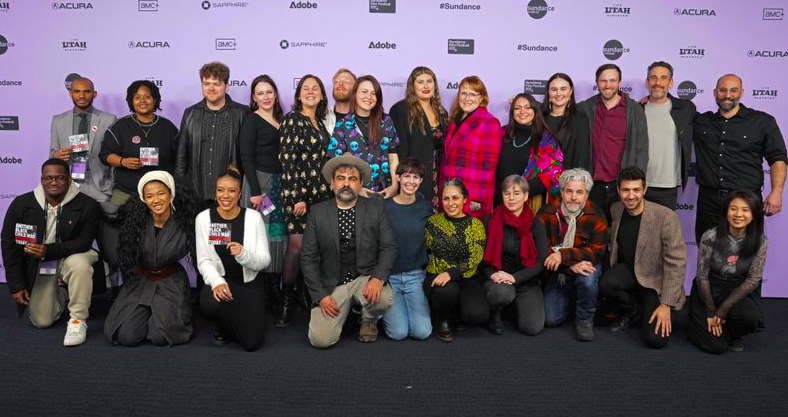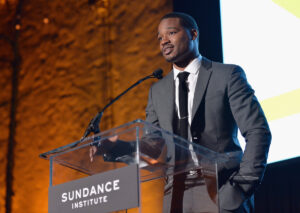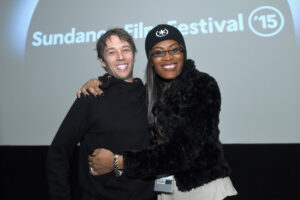The cast and crew of 2024 Sundance Film Festival’s Documentary Shorts. (Suzanne Cordeiro/Shutterstock for Sundance Film Festival)
By Veronika Lee Claghorn
Brick bungalow houses along a busy street in North Carolina. A blinking horse galloping against the backdrop of a wide open sky. A Geiger counter beeping indicating that radiation is nearby in the Ural Mountains. Candles flickering at a funeral memorial service. Women in Iran lowering their hijabs in order to conceal their identities. A businesswoman negotiating an art deal standing in front of a building covered in oil paint. These are just a few breathtaking scenes from the 2024 Sundance Film Festival’s Documentary Short Film Program.
Filmmakers, subjects, and producers took to the Ray Theater stage on January 20 to share with Festivalgoers their inspirations and hopes for their nonfiction projects.
To Be Invisible: According to statistics in Myah Overstreet’s documentary debut, over 50 percent of all parents and children involved in the foster care system in the United States are low income, and disproportionately Black, American Indian, and Latine. This film explores two families’ separation at the hands of Child Protective Services in the Raleigh-Durham area. “I was doing a lot of writing and research at [U.C. Berkeley] when I came across Amanda’s story,” explains the New York City–based journalist and filmmaker, before inviting Amanda [Wallace], one of the mothers in the documentary, to the stage. “Both of these mothers are extremely strong…Kelly is still fighting and she was gagged and [prevented from being here today]. She can only visit her children [for two hours] every week…only if she is quiet enough and invisible enough will they allow her to see her children,” says Wallace.
Winding Path: Eastern Shoshone medical student Jenna Murray speaks about her childhood summers spent with her grandfather and his many horses on the Wind River Indian Reservation. Watching him stitch up an injured horse inspired her to study medicine, especially because she knew medical resources were scarce for Indigenous populations. After struggling with alcoholism, Murray returned to her homeland for healing. This location may seem an unlikely fountain of wellness restoration — Wind River has been chronicled in the media as a place where many women and children end up missing. “I’m not Shoshone and I did not come from [this reservation],” says director Alexandra Lazarowich. “When you Google ‘Wind River,’ you are not getting Indigenous stories. Hopefully now if someone looks up Wind River, they can see the beauty of this place and it changes stereotypes of what people think of Indigenous communities across [the Americas.]”
Object 817: Olga Lucovnicova’s film could be summarized as being about an alleged alien discovery made in the Ural Mountains, on the edge of Siberia, around 1996. But it’s so much more. Like this year’s Sundance Spotlight entry The Mother Of All Lies, Lucovnicova’s documentary shows in a succinct amount of time the unraveling of a geographical location’s truth. While the Russian steppes are seemingly peaceful and untouched, they hide a terrible secret that even the locals don’t know very much about: roughly two miles from where the documentary takes place, a nuclear disaster took place at the Mayak Plutonium Plant. Created in 1948 under strict confidentiality, the plant led to the radioactive contamination event of 1957, 30 times larger than Chernobyl, that polluted all of the nearby towns, waterways, flora, and fauna. Fascinated by this since she was nine years old, Lucovnicova says, “I wanted people to think about the impact of the military industry and nuclear weapons and how many people are killed before a nuclear weapon is [decimated].”
The Smallest Power: Director Andy Sarjahani, an Iranian-American filmmaker working in the American South, was far from home when he learned of the passing of Jina Mahsa Amini. Mahsa Amini’s death in 2022 raised eyebrows in the female population of Iran, causing mass outrage and unrest from women tired of living under strict rules. Enter animator Naghmeh Farzaneh, who spent much of her life in Iran. When she first connected with Sarjahani to discuss his short about the female-led Woman, Life, Freedom uprising, she immediately had flashbacks to the country’s Green Movement. Farzaneh says she wanted her artwork to convey “determination, fear, and a feeling of unity” all at once.
14 Paintings: Director Dongnan Chen says that the subject of her documentary hits close to home as it is her home. Her native city, Shenzhen, China is home to many kinds of paintings, some original and many dupes. “It’s a weird city with historic buildings but also has the largest supplier of copies of Western masterpieces,” explains Chen. Her piece explores the clash of original artworks with the background of literal copies of copies. She started research for her film at the end of 2022 when she tested positive for Covid and was quarantined in China’s Vienna Hotel. “There was a reproduction of a classic girl from Europe and I spent a whole week alone with it,” she says. Surrounded by Western World classical art replicas, Chen naturally found her muse in the Shenzhen environs.
Bob’s Funeral: Sometimes the only way people can get through tough times is through having gallow’s humor. No disrespect to the Midwest, but Jack Dunphy’s video treatise on the ways in which his particular family copes with death could be punctuated by ranch dressing and a passive aggressive “ope.” (Don’t worry, the filmmaker would probably chuckle at this analogy). His Sundance Short Film Jury Award: Nonfiction Prize–winning piece examines his family’s bizarre nonrelationship with his estranged grandfather, Bob, who was known primarily in life for his bad temper and not much else. This short documentary was formed from the ashes of footage Dunphy generated when filming his father’s hospice care nonstop — the filmmaker claims it was a “trauma response.” Out of eight years of animated footage from his father’s own feature length narrative, Dunphy pulled out bits of the “wreckage” just to “whip something up for Sundance.”







